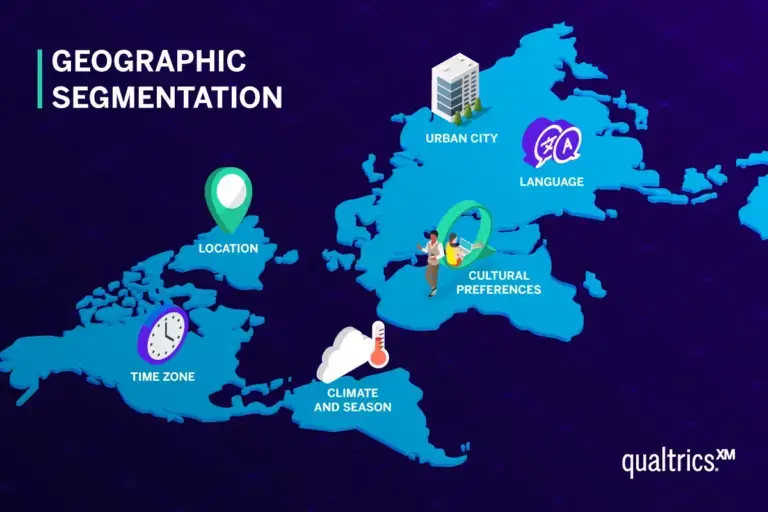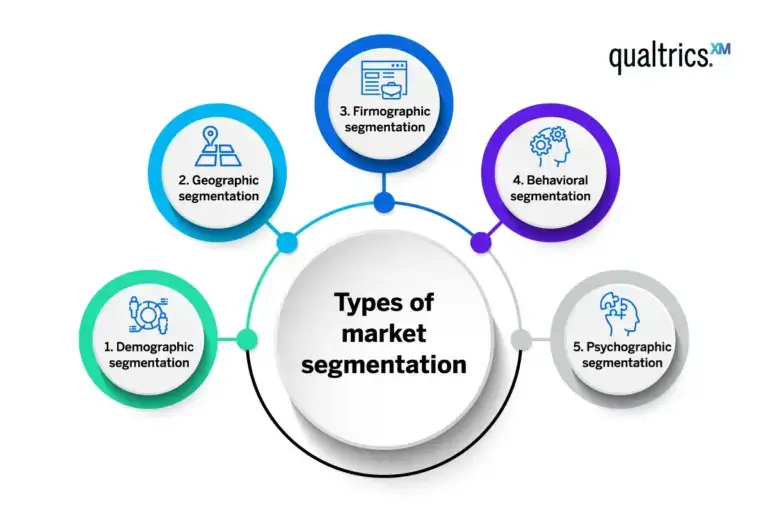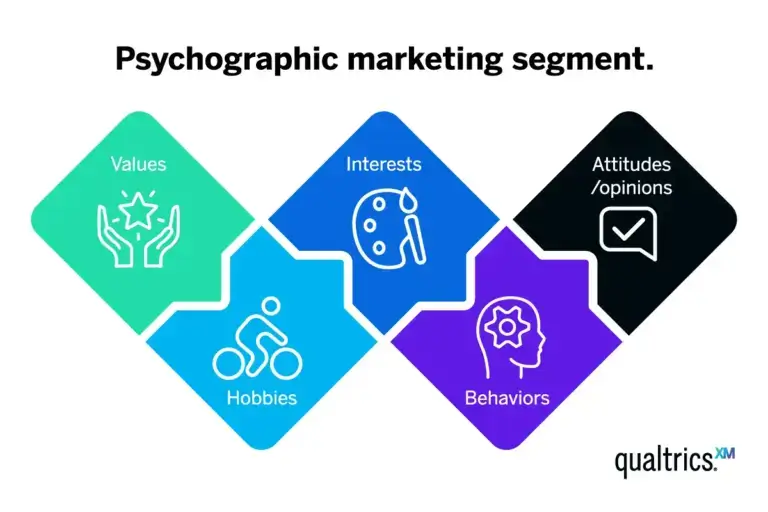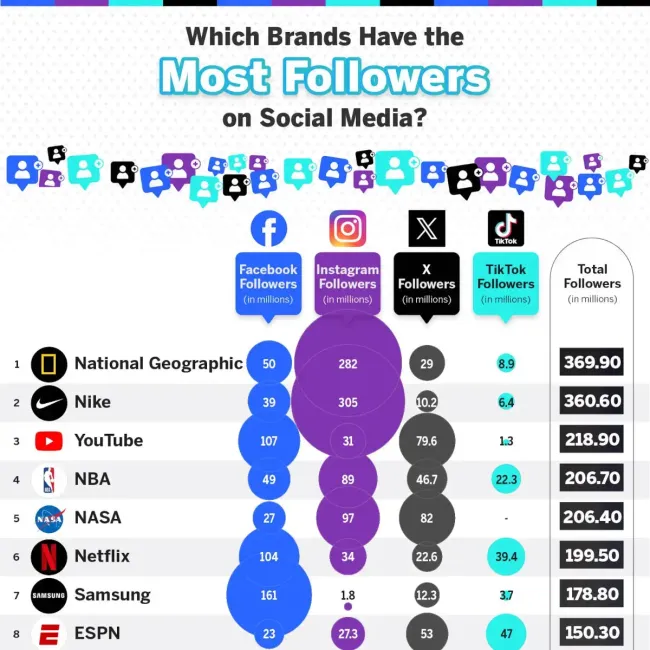What is geographic segmentation?
Geographic segmentation is the practice of dividing your audience based on geographic location, from country right down to postcode. It’s used to target products, services or marketing messages at people who live in, work in, or shop at a particular location.
While geographic segmentation has its fans, it also has many flaws. One major drawback is that geographic segments often overlook cultural preferences and the complexity of consumer behaviour; just because two people live in the same postcode doesn’t mean they have the same needs or interests. Relying solely on geography for market segmentation could lead to missed opportunities and, in some cases, wasted resources.

Why marketers use geographic segmentation
Marketers may opt to use geographic segmentation for a variety of reasons.
For starters, it’s relatively easy to implement into a marketing strategy, thanks to personal data like home address and location data being straightforward to collect and analyse. Plus, it offers immediate insights into a target area’s demographics, which can be invaluable for local businesses or location-specific campaigns.
Marketers often use geographic segmentation to explore market potential in a given area or to optimise distribution channels. It’s also handy for understanding regional trends and preferences, which can be crucial for businesses looking to expand into new territories.
However, it’s essential to note that while geographic segmentation provides a snapshot of ‘where’ your audience is, it doesn’t delve into the ‘why’ behind consumer behaviours – that’s where psychographic segmentation comes in. It’s a bit like judging a book by its cover; you get the basics but miss out on the nuanced storyline.
While geographic segmentation can be a useful tool in marketing strategies, it often needs to be combined with other segmentation methods for a fuller picture.
Free eBook: How to drive profits with customer segmentation
Geographic segmentation examples
Geographic segmentation is a versatile tool that can be employed in various ways, depending on your goals, audience and the unique characteristics of the locations you’re focused on.
Below are examples of organisations and use cases that geographic segmentation can bring value to.
Political groups
Geographic segmentation is particularly useful in the political realm, where location often correlates with long-held political opinions or the historical dominance of certain parties.
By identifying and targeting areas that are more likely to align with their ideology, political groups can concentrate their fundraising and canvassing efforts more effectively – maximising return on investment.
Clothing brands and retailers
Fashion needs and preferences vary from place to place, influenced by local culture and, of course, the weather. As a result, clothing brands and retailers will adjust their inventory based on geography.
For example, the same retailer has stores in both a beach town and a ski resort. The beach location might stock up on flip-flops and bathing suits, while the ski resort location will stock clothes designed for colder temperatures.
Home security companies
Home security companies often focus their marketing efforts in high-crime areas where the perceived need for their services is higher.
For instance, a company might offer special package deals or partnerships with local law enforcement in these regions – adding an extra layer of trust and security for potential customers.
Swimming pool suppliers
A company specialising in outdoor swimming pools will naturally target areas with warmer, sunnier climates, like Florida or California, to maximise its profits.
By targeting an audience that’s more likely to buy their products, the suppliers will in turn optimise their marketing and advertising spend.
The problems with geographic segmentation
While geographic segmentation has its merits, it’s far from a foolproof strategy. Here are the more significant issues you may encounter when employing this method.
It doesn’t account for nuance in locations
Even within smaller geographic units like neighbourhoods, there can be a vast range of demographic, cultural, attitudinal and behavioural differences – particularly in neighbourhoods with a high population density, such as those in big cities. As a result, what appeals to one person might be irrelevant or even off-putting to their next door neighbour.
The reality is that people’s interests can be wildly different even if they live in the same neighbourhood.
Take a postcode that’s home to young adults in their mid-20s, families with small children and retirees. Add a mix of white-collar and blue-collar workers, various ethnic backgrounds, and diverse types of housing – from apartments to multi-million-dollar homes. A marketing message tailored for one segment could entirely miss the mark for another, despite the geographic proximity.
It carries the risk of missing the right people
Unless the targeted geographic area is entirely homogeneous – which is rarely the case – when you focus purely on geography you might not be reaching the people who are genuinely interested in what you have to offer.
You could end up wasting valuable resources, like time and advertising dollars, on an audience that’s not well-aligned with your product or message.
It gives limited opportunity for personalisation
One of the biggest trends in marketing today is personalisation. Geographic segmentation, however, offers limited scope for tailoring messages to individual preferences, because you’ve only identified people based on location.
While you might get the city or neighbourhood right and add a level of personalisation based on that, you’re missing out on the chance to connect on a deeper, more personal level.
It puts an overemphasis on location
Geographic segmentation can sometimes lead to an overemphasis on location at the expense of other important factors.
For example, businesses may ignore online or social trends that are equally, if not more, influential on consumer behaviour. In today’s digital age, physical location isn’t the only parameter that matters, and relying solely on it can result in missed opportunities.

Psychographic vs. geographic segmentation
While geographic segmentation groups people by where they are, psychographic segmentation groups them by who they are.
Here we explore the core reasons why the latter is a more powerful tool for marketers.
Psychographics dominate daily life
Psychographic factors guide most of our life choices – from who we befriend, to the career we pursue. They serve as the invisible hand that informs daily decisions.
Today, psychographic factors like interests, hobbies and personal values offer a more rounded view of who your customers actually are. And the big change of late is that this information has become much easier for brands to access from their target audiences.
Psychographic understanding beats knowing a postcode
Knowing where someone lives might give you a clue about their income or local culture, but it doesn’t tell you much about what drives them to make a purchase. On the other hand, understanding a person’s attitudes, values, interests, attitudes and opinions allows you to speak directly to their ‘why’ – and that’s exactly what psychographic segmentation is all about.
When you understand the ‘why’, you can offer solutions that are far more compelling than anything a postcode could ever suggest.
Psychographic factors create a more holistic understanding
By focusing on psychographics, marketers can connect with consumers on a more personal and emotional level, driving both engagement and loyalty.
Brands that tap into the psychographics of their audience are much better equipped to craft messages that resonate on a deeper level, and build a stronger emotional connection with consumers.

Psychographic segmentation factors – and examples of brands succeeding with them
Psychographic segmentation allows for a deeper, more meaningful way to create effective marketing campaigns.
It’s an approach that’s used to segment your audience based on a combination of the most common psychographic factors: values, hobbies, interests, behaviours, and attitudes and opinions.
Let’s look at why each factor is crucial to the blend of psychographic segmentation – and how they’re put to use by some of the world’s biggest brands.
Values
Values often play an important role in any psychographic segmentation. A core value in today’s world is environmental consciousness.
This could mean anything from actively participating in eco-friendly activities, to prioritising sustainable choices in everyday life. People with this value are often more willing to pay a premium for eco-friendly products and are more likely to support brands that align with their values.
Patagonia has zeroed in on this segment by offering truly sustainable outdoor clothing and gear, and living its environmental values to the fullest. It’s a brand that doesn’t just sell products; it sells a vision of environmental stewardship that deeply resonates with a target audience that places immense value in this.
Interestingly, genuinely sustainable brands like Patagonia also benefit from the interest of another audience that isn’t necessarily driven by eco-consciousness. Instead, this audience first and foremost values the badge of honour that comes with wearing a widely celebrated brand.

Hobbies
Hobbies offer another dimension for psychographic segmentation. In the case of motorcycle riding, it’s not just an activity but a hobby that’s really a lifestyle, community and even a sense of identity for many. Naturally, those who are passionate about riding often seek brands that understand and cater to this hobby.
Harley Davidson is more than just a motorcycle brand; it’s a lifestyle. It has successfully tapped into this psychographic segment by providing not just bikes but an entire culture around riding. From merchandise to social events, Harley Davidson serves the unique needs and wants of motorcycle enthusiasts

Interests
Interests are a crucial element in psychographic segmentation because they often dictate the products, services and brands that consumers want to interact with. Nowhere is this more true than in the realm of health and fitness. Be it the latest superfood, workout trend or cosmetic breakthrough, consumers are very open to being targeted based on their interest in the space.
The Ordinary is a skincare brand that has honed in on the interests of consumers who are keen on science-backed, ingredient-focused skincare. By offering detailed information on active ingredients and their effects, The Ordinary has captivated a market that wants more than just superficial solutions – setting the brand apart in a saturated beauty market.
Behaviours
People are increasingly grouped based on the behaviours they engage in regularly. When looking at younger audiences, one of the chief daily behaviours is of course using social media.
Instantaneous interactions are particularly popular among this demographic – aligning with a desire for more casual, less permanent digital interactions.
Snapchat understood the value of this form of communication. With features like disappearing messages and short-lived stories, they introduced a new social media platform that perfectly fit with the communication preferences of younger generations.

Attitudes and opinions
Attitudes and opinions form a critical part of psychographic segmentation, often driving consumers toward brands that align with their personal viewpoints. This could be anything from political leanings to cultural attitudes, such as body positivity and mental health advocacy.
Ben & Jerry’s is a brand that has found success from making a public stand on social issues like racial justice and climate change. Whether by design or not, this has attracted a consumer base that sees their purchase as an extension of their own values and opinions. Far beyond selling ice cream, Ben & Jerry’s is a brand that stands for something – making it far more attractive to those who share similar viewpoints.
Design the experiences people want next
Now you know segmentation do’s and don’ts, why not delve deeper into understanding audience trends and behaviours to craft experiences that truly resonate in the future?
Enter XM For Strategy & Research, Qualtrics’ advanced market research solution combining sophisticated research methodologies and analytics.
- Speed up insights on market and consumer trends with an all-in-one data system.
- Lower research expenses by moving it in-house and using tech for early concept evaluation.
- Boost research quality with targeted respondents and AI-driven data analysis.
In a single platform, XM For Strategy & Research offers everything you need to design experiences that power breakthrough products and services.


